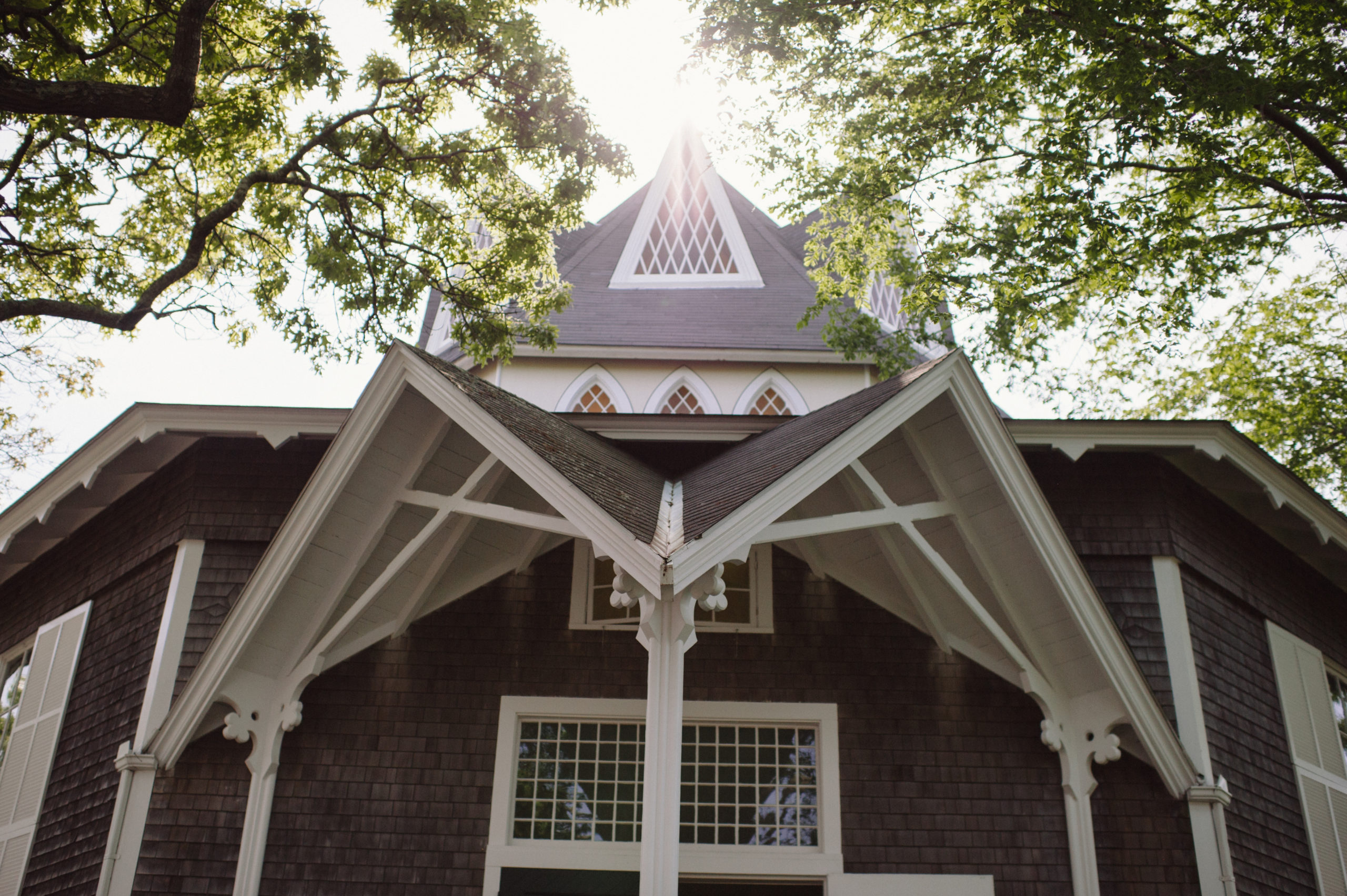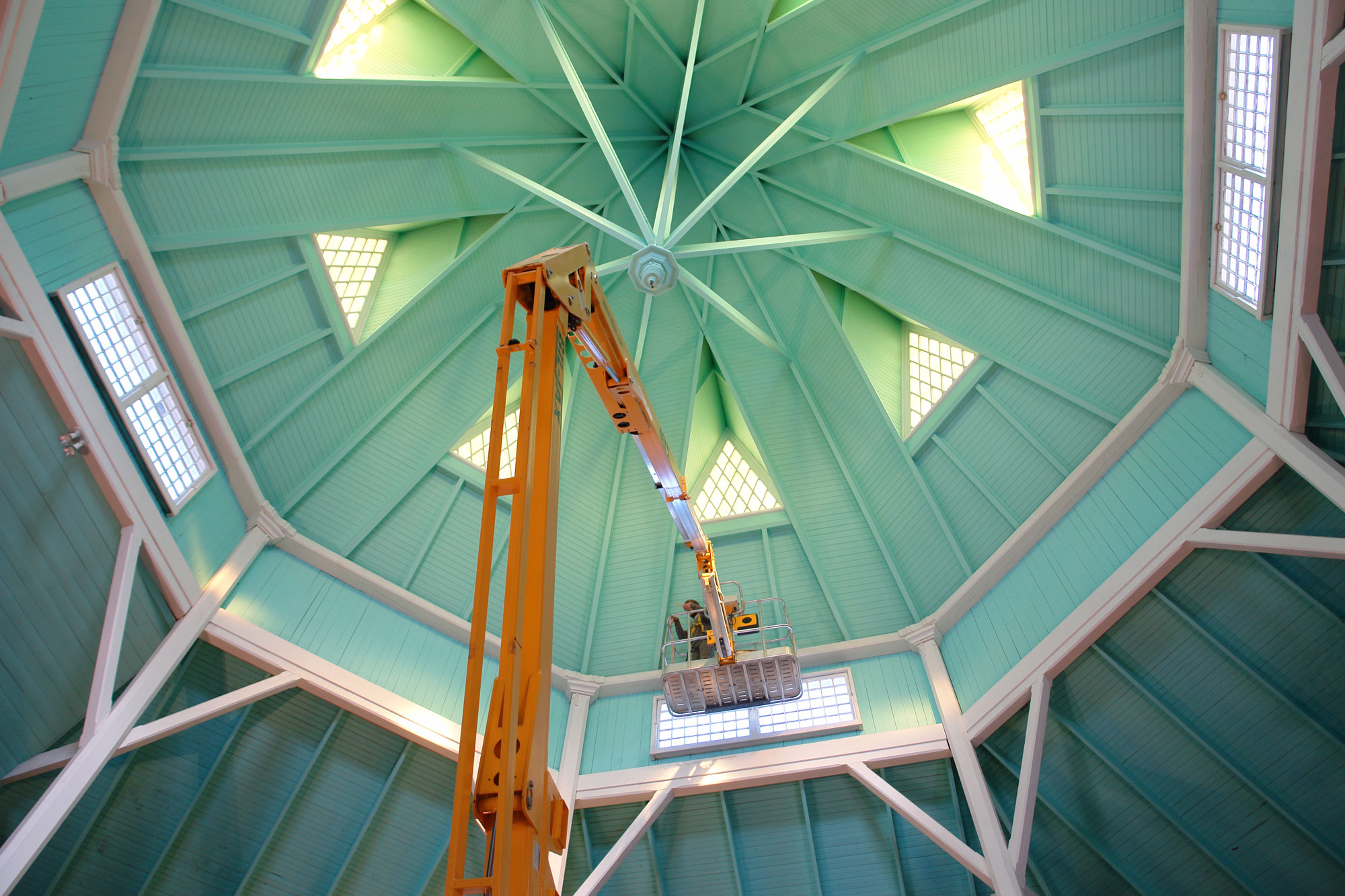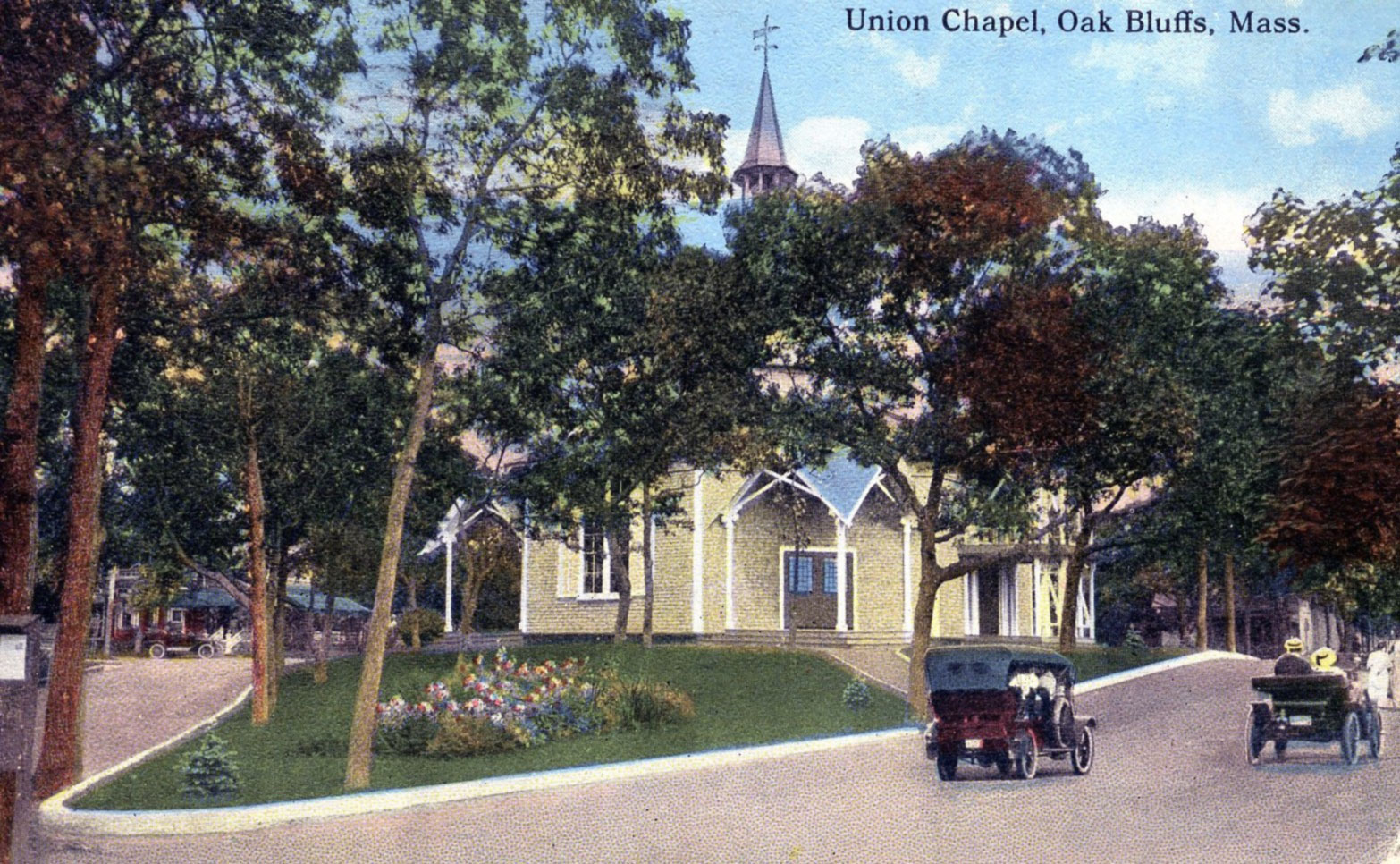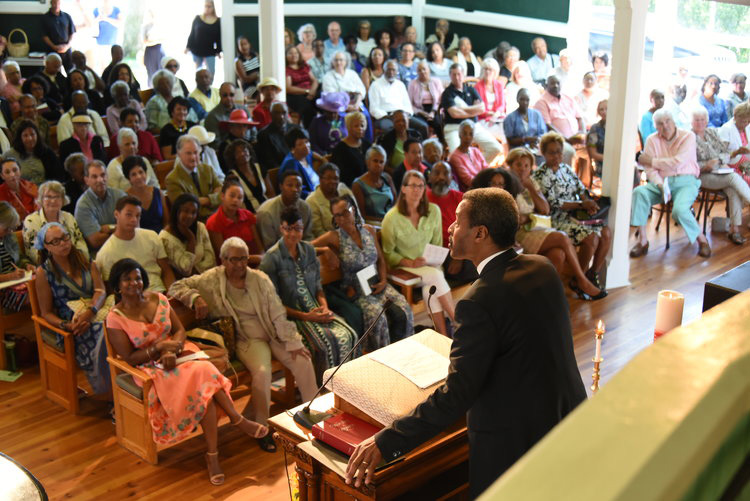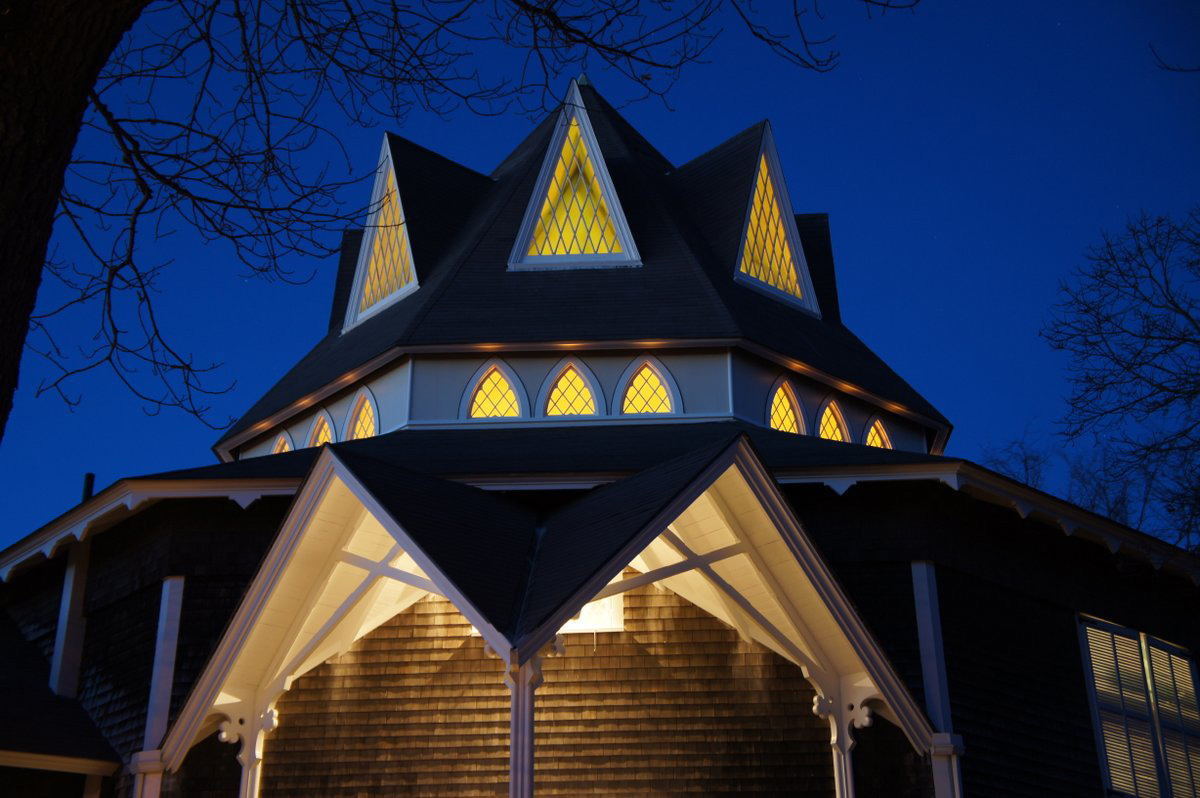Union Chapel
About
Built as a non-sectarian place of worship in 1870, Union Chapel’s unique octagonal design rises into a soaring open cupola with diamond-pane glass windows. Its excellent acoustics, ethereal, airy interior, and seating in the round make an event in this structure intimate and memorable.
Architectural Gem
Designed in the Stick Style by island resident Samuel Freeman Pratt (1824-1920), Union Chapel in Oak Bluffs is one of the island’s most engaging structures. Little is known about Pratt, but his midlife was spent as an architect when he designed several buildings on Martha’s Vineyard where he designed the gateway to the wharf in Oak Bluffs, the Arcade on Circuit Avenue, a band pavilion on Sea View Avenue, the architecturally significant octagonal shaped Union Chapel and about 18 private homes. Mr. Pratt had no known architectural training, yet his work is characterized as having a dynamic and festive style, similar to 16th-century French secular buildings. Architectural historian Ellen Weiss describes the structures as sharing “activated skylines with jerkinhead gables, candle snuffers, steep-hipped roofs, finials, dormers, and eaves that kick out, bending roof and dormer lines at their edges in a lilting fashion.”
Of the many architectural styles prevalent in the United States during the Victorian era, the Stick Style was the most expressive of a building’s underlying structure. Decorative wood trim, called stick work, was applied to the exterior to emphasize the basic wood frame structure. Popular between 1860 and 1890 and built predominantly in wood, few pure examples of the style remain. However, many fine examples of Stick Style may be hidden beneath slipcovers of aluminum, vinyl, stucco, or shingle installed to modernize an older structure’s appearance. Such is the case of the Union Chapel, which once had exuberant and playfully patterned shingles in the roof as well as along the exterior walls.
The Stick Style evolved from the work of architect Gervase Wheeler, an English immigrant and author of Rural Homes or, Sketches of Houses Suited to American Country Life, an influential treatise on residential architecture first published in 1851. The book popularized Wheeler’s ideas on design, particularly his notion that buildings should be structurally truthful. Pattern books such as this may well have been within the reach of Samuel Pratt, whose father was a carpenter. The principle of “truthful” building designs was also evident in the cottages being constructed in the Camp Meeting Association properties in Oak Bluffs. It is quite possible that Mr. Pratt adapted what he saw locally when he began his design of Union Chapel.
Union Chapel is a beautiful example of Stick-style architecture with many elements on display. It is an octagonal building with a steeply pitched roof, tall proportions, and decorative structural overlay. Large ex-brackets form curved diagonal braces along the porches covering the three entrances. Extended rafters with brackets support the overhanging roof at both the ground level and the balcony level, and applied Gothic trim frames the windows. Large sash windows fit into the rectangular pattern of the façade, which is sheathed in wood shingles. On the interior of the structure, all of the framing members are exposed, and the rafters for the roof are visible. Together with the soft light created by the triangular windows on the roof, they create an airy, soaring interior imbued with a feeling of tranquility.
When it was originally constructed in 1870, Union Chapel fairly dripped with architectural details. A conical spire stood atop the peak of the octagonal roof. Metal finials in the shape of a stylized fleur de lis were installed on the gable end of each of the upper triangular windows and on the porch roof at each entrance. The roof itself had a stripe pattern that was demarcated by specially cut shingles and a change in the color palette. Decorative iron coursework ran along the roof’s rim at the building’s lower level. Finally, the primary entrance to the building was built with an extended porch above which stood a bell tower with a steeply pitched octagonal roof with decorative shingles and a grand finial. Sadly, much of the exterior ornamentation did not survive. The Great New England Hurricane of 1938 destroyed many fine Vineyard buildings, including parts of the Union Chapel. Despite the damage, many traces of the Stick Style can be found in Union Chapel, one of the island’s enduring and beloved landmarks.
Island Life
Designed by Samuel Freeman Pratt, Union Chapel was built in 1870 at a cost of $16,000 on a mound of land known as Chapel Hill. The original building had a tall steeple with matching finials on the triangular windows, intricate wood carvings on the balconies and a large bell tower. The Chapel was built as the focal point of what is today the Copeland District, an area designed by Robert Morris Copeland in the Frederick Law Olmstead Park tradition of open spaces and twisting streets. It was built in conjunction with four or five spec houses and the Chapel was part of the sales pitch. From the entrance of Union Chapel, prospective home buyers could look out to their property and see the Sound and Ocean Park and imagine family going to the Chapel on Sundays, which was the custom. The developers wanted Union Chapel to be impressive and so Pratt delivered to them a showplace in Stick Style architecture that would entice and inspire buyers.
Union Chapel was built in a beautiful octagonal shape on a small rise of land at the intersection of Circuit, Narragansett, and Samoset Avenues. Mr. Pratt is estimated to have designed twenty-two structures in the young town of Oak Bluffs, including the gateway to the Wharf and the Seaview Hotel. The Chapel took one year to build, completing it in 1871, seating 400 with a spire reaching an altitude of 96 feet, and a final construction cost of $16,000. It opened its first service in August, 1871.
Union Chapel was built during a time when summer visitors came to the Vineyard by steamer and flocked to the Methodist camp meetings in the neighboring Camp Ground. Concerned about fostering a quiet and dedicated religious environment, the Methodists built a fence around the Camp Ground to separate practitioners from the rest of the town. Lacking a central chapel, the Oak Bluffs Land and Wharf Co. decided to build a chapel where all forms of theology could be practiced. From the start, Union Chapel has hosted preachers of different denominations from all over the Northeast, each taking the pulpit in turn. A series of services from the 1930s included Presbyterians, Lutherans, Baptists, and Episcopalians. To this day, Union Chapel remains a non-denominational place of worship, drawing large crowds for diverse services every summer. This model enabled families from diverse backgrounds to partake of the inspirational atmosphere of the island during annual meetings and spiritual revivals, even if not part of the Methodist gatherings at the Martha’s Vineyard Camp Ground Association. Today, Union Chapel continues to offer island visitors and residents with a space for non-denominational services and is also used for a wide array of events, including lectures, films, concerts, dance and performing arts.
Union Chapel’s glorious history includes not only world-renowned preachers of all denominations and first-class music but also political events. It was in Union Chapel that meetings were held that led to Oak Bluffs’ secession from Edgartown in 1880. After secession, the Chapel hosted town meetings and high school graduations for a number of years and has been referred to as the center of the Oak Bluffs community.
Faith & Inspiration
Imagine it’s a bright August morning in Oak Bluffs and the windows and doors of Union Chapel are open wide. Through those openings come notes of inviting music – the organist plays organ preludes as congregants enter the Chapel. Some folks find their favorite seats in the pews or along the balcony, while others greet friends and acquaintances. Later, they will join the organ and the Chapel quartet in congregational singing and vocal selections ranging from works of Bach, Mozart, and Schütz to African American Spirituals, gospel, and jazz. Services at Union Chapel are as diverse as the music.
From its earliest days in the 1870s, Union Chapel has served as an interdenominational church that welcomes all islanders and island visitors. Today, Union Chapel continues to host a series of inspirational preachers who hail from all over the United States and have diverse backgrounds, religions, and home places of worship. Sunday services at Union Chapel have an extraordinary power to move people. This place and the idea behind it remind people of the power of union, in every word and experience. It provokes thought, refreshes spiritual connections, fosters conversation, honors community and has, for generations of islanders, served to inspire faith in the human spirit.
Connect with this landmark
A non-denominational site, Union Chapel hosts weekly religious services, as well as concerts, dance performances, presentations and much more.
Support
Support this landmarkOak Bluffs, MA
